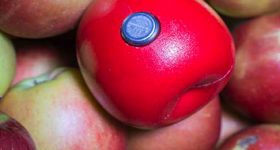3D-Printed Fruit Will Help Your Real Apples Taste Better
You know what they say, an apple a day keeps the doctor away! I’m one of those people who has to have fruit every single day – whether it’s bananas for breakfast, or a big helping of berries at lunch, if I miss out on my daily dose of fruity goodness, I am not a happy camper…I do still have to visit the doctor, though. I know the stores in my area that carry the best fruit, and the ones to avoid due to low fruit quality. Fruit doesn’t always make it safely from the plantation to the retailer, due in large part to refrigeration issues inside the cargo containers. Empa, the Swiss Federal Institute of Technology Domain interdisciplinary research institute, recently came up with a way to fix this common problem…and of course, 3D printing played a role in the solution (no, it’s not 3D printed fruit).
 Refrigeration is very important for fruit: it kills larvae which nest inside, and helps maintain quality and freshness. Fruit is inspected regularly on its journey, but monitoring capabilities still have a long way to go. The current methods for measuring temperature inside fruit cargo containers are not completely reliable – while current measuring devices can measure the air temperature inside, the core temperature inside the individual pieces of fruit is what’s more important in terms of quality. Sensors are able to measure the inside of fruit, but the invasive method means sticking a sensor through the skin and into the middle of the “spy fruit.” Even this method is not 100% foolproof, as technicians tend to take a piece of fruit from the the front row of pallets in a container, which will be better refrigerated than fruit closer to the inside of the transport container; this distorts the sensor results. Empa, which has recently been involved with the nanotechnology ELENA Network established by the European Union, developed a kind of camouflage sensor that monitors the fruit cargo.
Refrigeration is very important for fruit: it kills larvae which nest inside, and helps maintain quality and freshness. Fruit is inspected regularly on its journey, but monitoring capabilities still have a long way to go. The current methods for measuring temperature inside fruit cargo containers are not completely reliable – while current measuring devices can measure the air temperature inside, the core temperature inside the individual pieces of fruit is what’s more important in terms of quality. Sensors are able to measure the inside of fruit, but the invasive method means sticking a sensor through the skin and into the middle of the “spy fruit.” Even this method is not 100% foolproof, as technicians tend to take a piece of fruit from the the front row of pallets in a container, which will be better refrigerated than fruit closer to the inside of the transport container; this distorts the sensor results. Empa, which has recently been involved with the nanotechnology ELENA Network established by the European Union, developed a kind of camouflage sensor that monitors the fruit cargo.
The artificial fruit sensor looks like fruit, acts like fruit, and travels with the fruit, to guarantee and monitor temperature. It simulates the relevant fruit’s composition, and is the same size and shape. Once the cargo arrives, the data from the fruit sensor can be easily and quickly analyzed, which researchers hope to use to learn more information about the temperature inside the containers of fruit during transport. Any deliveries not meeting quality checks can use sensor data to trace back in the supply chain the point where things went pear-shaped (or otherwise poorly, as pears hopefully retain their shape).
 To make the sensor, the fruit is first X-rayed, and a computer algorithm creates its average texture and shape. The exact composition of the fruit’s flesh is determined, through research and measurements, and simulated in the same ratio, with a mixture of polystyrene, water, and carbohydrates. Then, the mixture fills a 3D printed fruit-shaped sensor mold. Often, we hear objects described as being 3D printed that were in actuality just made using 3D printed molds, like deliciously detailed pieces of chocolate. We see 3D printed molds used often in the medical field, such as for a reconstructive cranioplasty surgery in Russia and 3D printed orbital eye socket molds. But the process is helpful for lots of other unique projects, from prototyping large wind turbine molds and 3D printed molds for monster crayons to benefit abused children, to 3D printed chess piece molds and making the perfect fishing lure…and now, 3D printed fruit sensor molds.
To make the sensor, the fruit is first X-rayed, and a computer algorithm creates its average texture and shape. The exact composition of the fruit’s flesh is determined, through research and measurements, and simulated in the same ratio, with a mixture of polystyrene, water, and carbohydrates. Then, the mixture fills a 3D printed fruit-shaped sensor mold. Often, we hear objects described as being 3D printed that were in actuality just made using 3D printed molds, like deliciously detailed pieces of chocolate. We see 3D printed molds used often in the medical field, such as for a reconstructive cranioplasty surgery in Russia and 3D printed orbital eye socket molds. But the process is helpful for lots of other unique projects, from prototyping large wind turbine molds and 3D printed molds for monster crayons to benefit abused children, to 3D printed chess piece molds and making the perfect fishing lure…and now, 3D printed fruit sensor molds.
The researchers learned that the same sensor doesn’t work for all fruits, so they created different sensors for the Kent mango, oranges, the Jonagold and Braeburn apple varieties, and the Cavendish banana.
Comments
Post a Comment